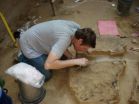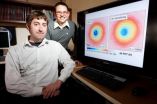(Press-News.org) WASHINGTON, April 20—For more than 150 years, spark plugs have powered internal combustion engines. Automakers are now one step closer to being able to replace this long-standing technology with laser igniters, which will enable cleaner, more efficient, and more economical vehicles.
In the past, lasers strong enough to ignite an engine's air-fuel mixtures were too large to fit under an automobile's hood. At this year's Conference on Lasers and Electro Optics (CLEO: 2011), to be held in Baltimore May 1 - 6, researchers from Japan will describe the first multibeam laser system small enough to screw into an engine's cylinder head.
Equally significant, the new laser system is made from ceramics, and could be produced inexpensively in large volumes, according to one of the presentation's authors, Takunori Taira of Japan's National Institutes of Natural Sciences.
According to Taira, conventional spark plugs pose a barrier to improving fuel economy and reducing emissions of nitrogen oxides (NOx), a key component of smog.
Spark plugs work by sending small, high-voltage electrical sparks across a gap between two metal electrodes. The spark ignites the air-fuel mixture in the engine's cylinder—producing a controlled explosion that forces the piston down to the bottom of the cylinder, generating the horsepower needed to move the vehicle.
Engines make NOx as a byproduct of combustion. If engines ran leaner – burnt more air and less fuel – they would produce significantly smaller NOx emissions.
Spark plugs can ignite leaner fuel mixtures, but only by increasing spark energy. Unfortunately, these high voltages erode spark plug electrodes so fast, the solution is not economical. By contrast, lasers, which ignite the air-fuel mixture with concentrated optical energy, have no electrodes and are not affected.
Lasers also improve efficiency. Conventional spark plugs sit on top of the cylinder and only ignite the air-fuel mixture close to them. The relatively cold metal of nearby electrodes and cylinder walls absorbs heat from the explosion, quenching the flame front just as it starts to expand.
Lasers, Taira explains, can focus their beams directly into the center of the mixture. Without quenching, the flame front expands more symmetrically and up to three times faster than those produced by spark plugs.
Equally important, he says, lasers inject their energy within nanoseconds, compared with milliseconds for spark plugs. "Timing – quick combustion – is very important. The more precise the timing, the more efficient the combustion and the better the fuel economy," he says.
Lasers promise less pollution and greater fuel efficiency, but making small, powerful lasers has, until now, proven hard. To ignite combustion, a laser must focus light to approximately 100 gigawatts per square centimeter with short pulses of more than 10 millijoules each.
"In the past, lasers that could meet those requirements were limited to basic research because they were big, inefficient, and unstable," Taira says. Nor could they be located away from the engine, because their powerful beams would destroy any optical fibers that delivered light to the cylinders.
Taira's research team overcame this problem by making composite lasers from ceramic powders. The team heats the powders to fuse them into optically transparent solids and embeds metal ions in them to tune their properties.
Ceramics are easier to tune optically than conventional crystals. They are also much stronger, more durable, and thermally conductive, so they can dissipate the heat from an engine without breaking down.
Taira's team built its laser from two yttrium-aluminum-gallium (YAG) segments, one doped with neodymium, the other with chromium. They bonded the two sections together to form a powerful laser only 9 millimeters in diameter and 11 millimeters long (a bit less than half an inch).
The composite generates two laser beams that can ignite fuel in two separate locations at the same time. This would produce a flame wall that grows faster and more uniformly than one lit by a single laser.
The laser is not strong enough to light the leanest fuel mixtures with a single pulse. By using several 800-picosecond-long pulses, however, they can inject enough energy to ignite the mixture completely.
A commercial automotive engine will require 60 Hz (or pulse trains per second), Taira says. He has already tested the new dual-beam laser at 100 Hz. The team is also at work on a three-beam laser that will enable even faster and more uniform combustion.
The laser-ignition system, although highly promising, is not yet being installed into actual automobiles made in a factory. Taira's team is, however, working with a large spark-plug company and with DENSO Corporation, a member of the Toyota Group.
INFORMATION:
This work is supported by the Japan Science and Technical Agency (JST).
CLEO: 2011 presentation CMP1, "Composite All-Ceramics, Passively Q-switched Nd:YAG/Cr4+:YAG Monolithic Micro-Laser with Two-Beam Output for Multi-Point Ignition," by Nicolaie Pavel of Romania's National Institute for Laser, Plasma and Radiation Physics; Takunore Taira and Masaki Tsunekane of Japan's Institute for Molecular Science; and Kenji Kanehara of Nippon Soken, Inc., Japan, is at 1:30 p.m. Monday, May 2 in the Baltimore Convention Center.
About CLEO
With a distinguished history as the industry's leading event on laser science, the Conference on Lasers and Electro-Optics (CLEO) and the Quantum Electronics Laser Science Conference (QELS) is where laser technology was first introduced. CLEO: 2011 will unite the field of lasers and electro-optics by bringing together all aspects of laser technology, with content stemming from basic research to industry application. Sponsored by the American Physical Society's (APS) Laser Science Division, the Institute of Electronic Engineers (IEEE) Photonics Society and the Optical Society (OSA), CLEO: 2011 provides the full range of critical developments in the field, showcasing the most significant milestones from laboratory to marketplace. With an unparalleled breadth and depth of coverage, CLEO: 2011 connects all of the critical vertical markets in lasers and electro-optics. For more information, visit the conference's website at www.cleoconference.org.
END
WASHINGTON — To help alleviate the effects of severe traumatic brain injury (TBI), the U.S. Department of Defense should ensure that all military personnel with this type of injury receive adequate protein and calories immediately after the trauma and through the first two weeks of treatment, says a new report from the Institute of Medicine. Evidence from several studies of severely brain-injured patients shows that providing energy and protein to patients early reduces inflammation and improves their outcomes, said the committee of experts who wrote the report.
This ...
Queen's University professor Kate Harkness has found that a history of physical, sexual or emotional abuse in childhood substantially increases the risk of depression in adolescence by altering a person's neuroendocrine response to stress.
Adolescents with a history of maltreatment and a mild level of depression were found to release much more of the stress hormone cortisol than is normal in response to psychological stressors such as giving a speech or solving a difficult arithmetic test.
"This kind of reaction is a problem because cortisol kills cells in areas of ...
BUFFALO, NY -- Exposure to air pollution early in life and when a woman gives birth to her first child may alter her DNA and may be associated with premenopausal breast cancer later in life, researchers at the University at Buffalo have shown.
The findings indicated that higher air pollution exposure at birth may alter DNA methylation, which may increase levels of E-cadherin, a protein important to the adhesion of cells, a function that plays an essential role in maintaining a stable cellular environment and assuring healthy tissues.
Methylation is a chemical process ...
Scientists seeking to understand the origin of the human mind may want to look to honeybees -- not ancestral apes -- for at least some of the answers, according to a University of Colorado Boulder archaeologist.
CU-Boulder Research Associate John Hoffecker said there is abundant fossil and archaeological evidence for the evolution of the human mind, including its unique power to create a potentially infinite variety of thoughts expressed in the form of sentences, art and technologies. He attributes the evolving power of the mind to the formation of what he calls the ...
Researchers at Rice University and Texas A&M have discovered a way to pattern active proteins into bio-friendly fibers. The "eureka" moment came about because somebody forgot to clean up the lab one night.
The new work from the Rice lab of biochemist Kathleen Matthews, in collaboration with former Rice faculty fellow and current Texas A&M assistant professor Sarah Bondos, simplifies the process of making materials with fully functional proteins. Such materials could find extensive use as chemical catalysts and biosensors and in tissue engineering, for starters.
Their ...
Despite economic anxiety and concern for the future of the country, most Houstonians perceive an improving quality of life locally and 90 percent believe that Houston is a better place to live than most other metropolitan areas, according to the 30th annual Kinder Houston Area Survey conducted by Rice University. The findings were released today during a luncheon hosted by the Greater Houston Partnership and Rice's Kinder Institute for Urban Research.
The survey showed that Harris County residents have become a little more upbeat in their personal economic outlooks ...
(Baltimore, MD) – Today, the Interactive Autism Network (IAN), www.ianproject.org, the nation's largest online autism research project, reveals the preliminary results of the first major survey on wandering and elopement among individuals with autism spectrum disorders (ASD), and announces the launch of a new research survey on the association between pregnancy factors and ASD. The wandering and elopement survey found that approximately half of parents of children with autism report that their child elopes, with the behavior peaking at age four. Among these families, nearly ...
As partners in the international research consortium named MetaHit, scientists from the University of Copenhagen have contributed to show that an individual's intestinal bacteria flora, regardless of nationality, gender and age, organises itself in certain clusters. The cluster of intestinal bacteria flora is hypothesised to have an influence on how we react to both our diet and medicine absorbed through the gastro-intestinal tract. The results have recently been published in the journal Nature.
Most people know about blood types, some also know about tissue types. However, ...
BUFFALO, N.Y. -- Did the early universe have just one spatial dimension?
That's the mind-boggling concept at the heart of a theory that University at Buffalo physicist Dejan Stojkovic and colleagues proposed in 2010.
They suggested that the early universe -- which exploded from a single point and was very, very small at first -- was one-dimensional (like a straight line) before expanding to include two dimensions (like a plane) and then three (like the world in which we live today).
The theory, if valid, would address important problems in particle physics.
Now, in ...
CHAMPAIGN, Ill. — Coastal residents and oil-rig workers may soon have longer warning when a storm headed in their direction is becoming a hurricane, thanks to a University of Illinois study demonstrating how to use existing satellites to monitor tropical storm dynamics and predict sudden surges in strength.
"It's a really critical piece of information that's really going to help society in coastal areas, not only in the U.S., but also globally," said atmospheric sciences professor Stephen Nesbitt. Nesbitt and graduate student Daniel Harnos published their findings in ...

